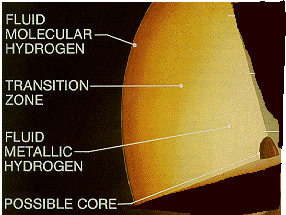This is a schematic of the interior of Saturn.
NASA
The Liquid Hydrogen Layer
The first liquid layer inside Saturn, right under the atmosphere, is the liquid hydrogen layer. The hydrogen atmosphere becomes thicker and thicker, like a dense fog, with more and more liquid droplets, until the hydrogen completely changes from the gas form to the liquid form. This changes occurs at roughly 1000 km (650 miles) below the level of the first cloud deck.
Once the hydrogen is a liquid, it then behaves like the ocean does in forming currents for the purpose of carrying heat from the inside to the outside of Saturn.
Under the liquid hydrogen layer is a layer made of liquid metallic hydrogen. This layer also forms complicated currents and motions, but because the layer is metallic, it is also able to conduct electricity. This is what produces Saturn's big magnetosphere.
You might also be interested in:

Motions in the interior of a planet help carry heat from the inside to the outside. The drawing to the left illustrates a kind of global motion that is typical of motions in the atmosphere as well as interior
...more
Magnetospheres are generated with 1.) magnetic materials and 2.) with motions within the magnetic material. The Earth-like planets generate magnetospheres from iron at the center. But Saturn has almost
...more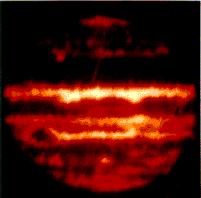
The energy that Jupiter and Saturn make has been found be very high. There are several ways in which astronomical objects make energy from inside. The first is by thermonuclear fusion, the way a star makes
...more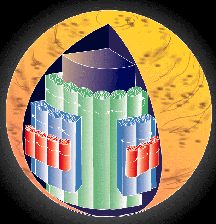
Motions, or currents in the interior of a gas-giant planet such as Saturn may be very different from the motions typical of the earth's interior. A second idea for the motions in the interior of a gas-giant
...more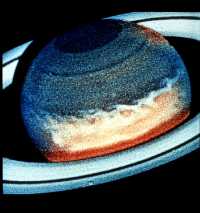
This image of Saturn makes use of false color to show the cloud pattern. The clouds form in bands which move across the disk of Saturn. The banded pattern of clouds, or stripes, is similar to those found
...more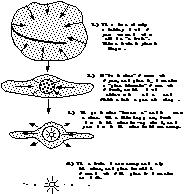
Scientists think that the solar system formed out of a spinning cloud of hydrogen and helium gas. Because the cloud was spinning, it flattened into a frisbee shape, just like a ball of pizza dough becomes
...more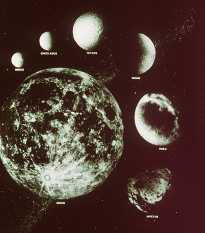
This is an image of the Earth's moon, shown in the lower left, with the much smaller icy moons of Saturn. The moons in order, starting from the top left are: Mimas, Enceladus, Tethys, Dione, Rhea, and
...more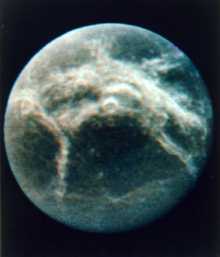
Dione was discovered by G. Cassini in 1684. Dione is the 7th farthest moon from Saturn, with a standoff distance of 377,400 km. It is a small icy moon, lightly cratered, with wispy white streaks across
...more


